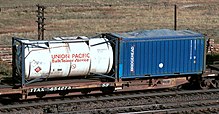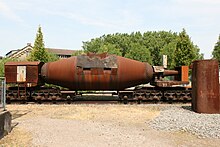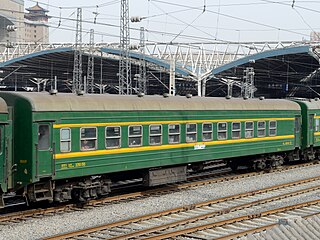
A railroad car, railcar, railway wagon, railway carriage, railway truck, railwagon, railcarriage or railtruck, also called a train car, train wagon, train carriage or train truck, is a vehicle used for the carrying of cargo or passengers on a rail transport network. Such cars, when coupled together and hauled by one or more locomotives, form a train. Alternatively, some passenger cars are self-propelled in which case they may be either single railcars or make up multiple units.
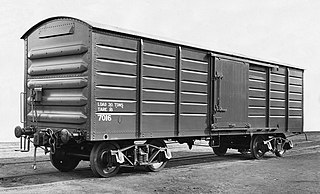
A boxcar is the North American (AAR) and South Australian Railways term for a railroad car that is enclosed and generally used to carry freight. The boxcar, while not the simplest freight car design, is considered one of the most versatile since it can carry most loads. Boxcars have side sliding doors of varying size and operation, and some include end doors and adjustable bulkheads to load very large items.

Intermodal freight transport involves the transportation of freight in an intermodal container or vehicle, using multiple modes of transportation, without any handling of the freight itself when changing modes. The method reduces cargo handling, and so improves security, reduces damage and loss, and allows freight to be transported faster. Reduced costs over road trucking is the key benefit for inter-continental use. This may be offset by reduced timings for road transport over shorter distances.

The Association of American Railroads (AAR) is an industry trade group representing primarily the major freight railroads of North America. Amtrak and some regional commuter railroads are also members. Smaller freight railroads are typically represented by the American Short Line and Regional Railroad Association (ASLRRA), although some smaller railroads and railroad holding companies are also members of the AAR. The AAR also has two associate programs, and most associates are suppliers to the railroad industry.
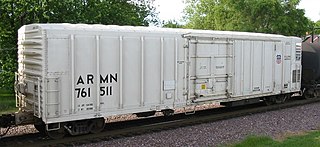
A refrigerator car is a refrigerated boxcar (U.S.), a piece of railroad rolling stock designed to carry perishable freight at specific temperatures. Refrigerator cars differ from simple insulated boxcars and ventilated boxcars, neither of which are fitted with cooling apparatus. Reefers can be ice-cooled, come equipped with any one of a variety of mechanical refrigeration systems, or use carbon dioxide or liquid nitrogen as a cooling agent. Milk cars may or may not include a cooling system, but are equipped with high-speed trucks and other modifications that allow them to travel with passenger trains.

A unit train, also called a block train or a trainload service, is a train in which all cars (wagons) carry the same commodity and are shipped from the same origin to the same destination, without being split up or stored en route. They are distinct from wagonload trains, which comprise differing numbers of cars for various customers.
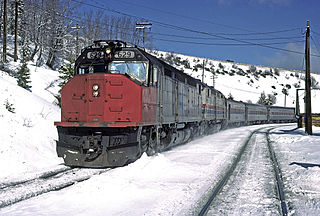
The EMD SDP40F was a six-axle 3,000 hp (2.2 MW) C-C diesel–electric locomotive built by General Motors Electro-Motive Division (EMD) from 1973 to 1974. Based on Santa Fe's EMD FP45, EMD built 150 for Amtrak, the operator of most intercity passenger trains in the United States. Amtrak, a private company but funded by the United States government, had begun operation in 1971 with a fleet of aging diesel locomotives inherited from various private railroads. The SDP40F was the first diesel locomotive built new for Amtrak and for a brief time they formed the backbone of the company's long-distance fleet.

Rail freight transport is the use of railways and trains to transport cargo as opposed to human passengers.
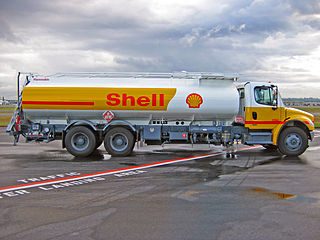
A tank truck, gas truck, fuel truck, or tanker truck or tanker is a motor vehicle designed to carry liquids or gases on roads. The largest such vehicles are similar to railroad tank cars, which are also designed to carry liquid loads. Many variants exist due to the wide variety of liquids that can be transported. Tank trucks tend to be large; they may be insulated or non-insulated; pressurized or non-pressurized; and designed for single or multiple loads. Some are semi-trailer trucks. They are difficult to drive and highly susceptible to rollover due to their high center of gravity, and potentially the free surface effect of liquids sloshing in a partially filled tank.
Milk cars are a specialized type of railroad car intended to transport raw milk from collection points near dairy farms to a processing creamery. Some milk cars were intended for loading with multiple cans of milk, while others were designed with a single tank for bulk loading. Milk cars were often equipped with high-speed passenger trucks, passenger-type buffer plates, and train signal and steam lines seldom found on conventional refrigerator cars.

A well car, also known as a double-stack car, is a type of railroad car specially designed to carry intermodal containers used in intermodal freight transport. The "well" is a depressed section that sits close to the rails between the wheel trucks of the car, allowing a container to be carried lower than on a traditional flatcar. This makes it possible to carry a stack of two containers per unit on railway lines wherever the structure gauge assures sufficient clearance. The top container is secured to the bottom container either by a bulkhead built into the car — possible when bottom and top containers are the same dimensions, or through the use of inter-box connectors (IBC). Four IBCs are needed per well car. In the terminal there are four steps: unlock and lift off the top containers of an inbound train, remove the bottom containers, insert outbound bottom containers, lock assembly after top containers emplaced. Generally this is done car-by-car unless multiple crane apparatus are employed.

A tank container or tanktainer is an intermodal container for the transport of liquids, gases and powders as bulk cargo. It is built to the ISO standards, making it suitable for different modes of transportation; as such, it is also called an ISO tank. Both hazardous and non-hazardous products can be transported in tank containers.

Goods wagons or freight wagons, also known as goods carriages, goods trucks, freight carriages or freight trucks, are unpowered railway vehicles that are used for the transportation of cargo. A variety of wagon types are in use to handle different types of goods, but all goods wagons in a regional network typically have standardized couplers and other fittings, such as hoses for air brakes, allowing different wagon types to be assembled into trains. For tracking and identification purposes, goods wagons are generally assigned a unique identifier, typically a UIC wagon number, or in North America, a company reporting mark plus a company specific serial number.
A liquid hydrogen tank car, also called liquid hydrogen tank wagon or liquid hydrogen tanker wagon is a railroad tank car designed to carry cryogenic liquid hydrogen (LH2). LH2 tank cars with a capacity of 17,000 pounds (7,711 kg) are used for transcontinental transport.
Janney couplers are a semi-automatic form of railway coupling that allow rail cars and locomotives to be securely linked together without rail workers having to get between the vehicles. They are also known as American, AAR, APT, ARA, MCB, knuckle, Buckeye, tightlock, Henricot or Centre Buffer Couplers.

The Lac-Mégantic rail disaster occurred in the town of Lac-Mégantic, Quebec, Canada, on July 6, 2013, at approximately 1:14 a.m. EDT, when an unattended 73-car Montreal, Maine and Atlantic Railway (MMA) freight train carrying Bakken Formation crude oil rolled down a 1.2% grade from Nantes and derailed downtown, resulting in the explosion and fire of multiple tank cars. Forty-seven people were killed. More than thirty buildings in Lac-Mégantic's town centre were destroyed, and all but three of the thirty-nine remaining buildings had to be demolished due to petroleum contamination. Initial newspaper reports described a 1 km (0.6-mile) blast radius.

In rail transport, the U.S. DOT-111 tank car, also known as the TC-111 in Canada, is a type of unpressurized general service tank car in common use in North America. Tank cars built to this specification must be circular in cross section, with elliptical, formed heads set convex outward. They have a minimum plate thickness of 7⁄16 inch (11.1 mm) and a maximum capacity of 34,500 US gallons. Tanks may be constructed from carbon steel, aluminum alloy, high alloy steel, or nickel plate steel by fusion welding.

The 2015 Mount Carbon train derailment refers to a derailment in Mount Carbon, West Virginia, on February 16, 2015, which involved a CSX Transportation train hauling 107 tank cars of crude oil from North Dakota to Virginia. It resulted in a large oil spill that caught fire with several subsequent large, violent fireball eruptions. The spill, fire, and eruptions destroyed one home, forced the evacuation of hundreds of families and caused the temporary shut down of two nearby water treatment plants. Eventually, 19 railcars carrying crude oil caught fire with each car carrying up to 30,000 US gallons of crude oil.

United Wagon Company is Russia's leading and one of the world's biggest manufacturers of freight cars. The company is on the Russian Ministry for Economic Development list of strategically important organizations.

A fuel container is a container such as a steel can, bottle, drum, etc. for transporting, storing, and dispensing various fuels.






